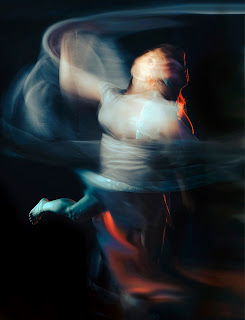Rachael Rutherford
The interests within my practice at large lie with portrayals of the body and how we heal through and with them. This has often been framed within the female body and it’s mis/treatment within healthcare settings.Using textiles and sculptural techniques, the nature of performance and self-portrayal comes through in the form of costume creation. The costume allows for sculptural elements to overtake the human form and in the context of my own practice, takes the internal and visualises it on the external.
Thinking through the work as a visual form and way of healing, textile coverings allow the self-portrayal to embody something beyond the human form, a monstrous re-imagining of the self. For me, the performative aspect comes through within the use of video as documentation of the wearing of the costume.
The creatures created exist within these videos as a way to create a barrier between the self and the audience, while creating an intimacy between the costume and its wearer that generally wouldn’t be able to exist with an audience present. It creates an opportunity for self-reflection and authenticity while still maintaining a measurable distance, and opportunity to push narrative through post-production editing.
This way of working gives a stronghold of control over the perception of the self’s image. To use the body first and foremost as a way to connect with the inner self, and then with the audience through the screen and narrated image of the familiar figure distorted.




That is a good point: the sensation of embodiment is to be performed within the mask of the costume; then, and only then you hand over affect to the viewer -- as a consequence the device works just as well for the stills image as for the video
ReplyDeleteTotally, I often find that the still images work great as documentation of the sculptural work, and that the video can be edited and further abstract any notions of the self, or derive a narrative and order of images/movements to create story.
DeleteI also think that costumes enable the performer to embody something different. I often use wigs and masks to help me to negotiate the visibleness and immediacy of performance while also making my identity in a way that hopefully allows me to universalise the performance actions - implying that they performed by a type of femininity rather than a specific human. (Dawn)
ReplyDeleteYes, I totally sympathise with this, to in a way remove the 'self' and rather embody an idea and feeling than a total visualisation of the self image, masking/disguising to be able to lean into the context of the work.
DeleteHi, do you wear these costumes out in public, is part of it to see there reaction and judgement?
ReplyDeleteHi there, I don't tend to wear costumes, or 'perform' with public audiences there, as I often feel it to performative and that I am acting, which is not something I wish to pursue with my creative practice - I tend towards something more intimate with the work created which I think can be explored more by the use of documentation with camera rather than with an audience.
DeleteThe consideration of having an audience present or not is interesting and so articulate.Performing alone creates a dynamic which focuses ones intentions very particularly. Once there are witnesses to a performance, the dynamic shifts and the focus of ones intentions has to shift also. In my own experience I have had to work hard not to become too self-conscious, once others were witness to my practice, and to not lose confidence. There is an interruption or an intrusion that can cause a disconnect within the act of creating.
DeleteInterestingly, this issue of the role/contribution of the audience - as more than passive consumers of the effort - figures across a number of the discussions running here; equally, quite a few contributors need the privacy/confidentiality of the lens alone.
DeleteIn some ways we have become so used to performing to camera - here I am thinking mainly of creating content for social media - that it is more natural to be alone with the camera than with the live audience. I do also believe that the lens is far more forgiving than our peers will ever be, and that with the use of the lens, we get greater control over who the audience for the resulting work may be and so retain an element of control over its dispersal.
DeleteThe idea of the costumes as a barrier is so important, especially when discussing the idea of the female body in relation to equal treatment through health-care. There is a constant through of not being believed - that if you express how you are truly feeling that they'll consider it an over-exaggeration. The idea of constant misdiagnosis to the point that you could wear all your problems outside of your body is very moving and emotional.
ReplyDeleteThe costumes walk on a thin line between removing the self image from the work as it masks and disguises but then is also so intimately personal, as the costumes are sculptural and have been made over hours of work by myself. All the feelings of the treatment of the body coming out into three dimensional shapes and then being stuck back onto the body, almost as if the thoughts are trying to put themselves back where they belong. Its an exposing of these internal instruments, things we often shy away from or don't view as suitable for public display being worn for the cameras eye and then displayed through video work further distancing viewers from the reality. Giving them an insight but understanding that they will never truly know the way in which it feels.
Delete